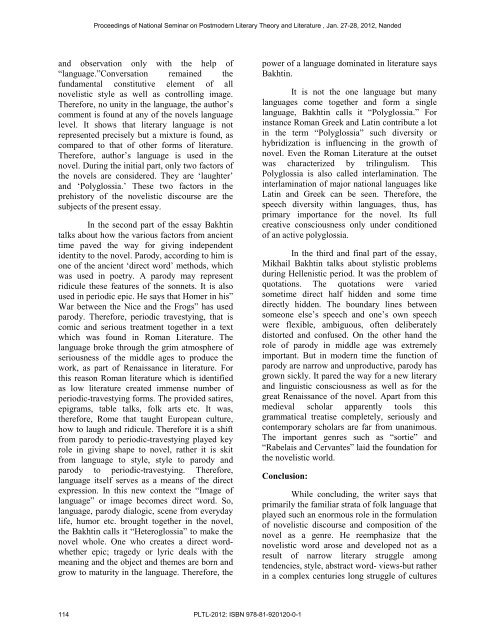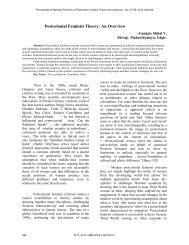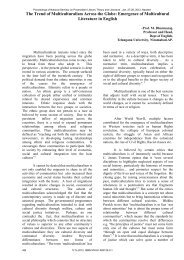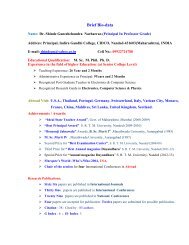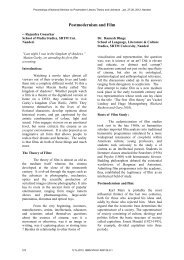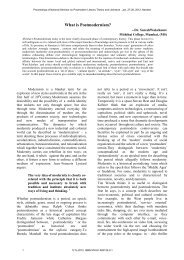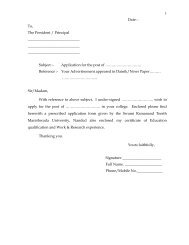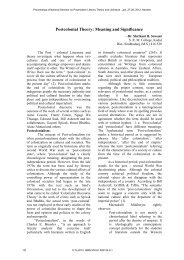Post-Structuralism: An Indian Preview - Igcollege.org
Post-Structuralism: An Indian Preview - Igcollege.org
Post-Structuralism: An Indian Preview - Igcollege.org
You also want an ePaper? Increase the reach of your titles
YUMPU automatically turns print PDFs into web optimized ePapers that Google loves.
Proceedings of National Seminar on <strong>Post</strong>modern Literary Theory and Literature , Jan. 27-28, 2012, Nanded<br />
and observation only with the help of<br />
“language.”Conversation remained the<br />
fundamental constitutive element of all<br />
novelistic style as well as controlling image.<br />
Therefore, no unity in the language, the author’s<br />
comment is found at any of the novels language<br />
level. It shows that literary language is not<br />
represented precisely but a mixture is found, as<br />
compared to that of other forms of literature.<br />
Therefore, author’s language is used in the<br />
novel. During the initial part, only two factors of<br />
the novels are considered. They are ‘laughter’<br />
and ‘Polyglossia.’ These two factors in the<br />
prehistory of the novelistic discourse are the<br />
subjects of the present essay.<br />
In the second part of the essay Bakhtin<br />
talks about how the various factors from ancient<br />
time paved the way for giving independent<br />
identity to the novel. Parody, according to him is<br />
one of the ancient ‘direct word’ methods, which<br />
was used in poetry. A parody may represent<br />
ridicule these features of the sonnets. It is also<br />
used in periodic epic. He says that Homer in his”<br />
War between the Nice and the Frogs” has used<br />
parody. Therefore, periodic travestying, that is<br />
comic and serious treatment together in a text<br />
which was found in Roman Literature. The<br />
language broke through the grim atmosphere of<br />
seriousness of the middle ages to produce the<br />
work, as part of Renaissance in literature. For<br />
this reason Roman literature which is identified<br />
as low literature created immense number of<br />
periodic-travestying forms. The provided satires,<br />
epigrams, table talks, folk arts etc. It was,<br />
therefore, Rome that taught European culture,<br />
how to laugh and ridicule. Therefore it is a shift<br />
from parody to periodic-travestying played key<br />
role in giving shape to novel, rather it is skit<br />
from language to style, style to parody and<br />
parody to periodic-travestying. Therefore,<br />
language itself serves as a means of the direct<br />
expression. In this new context the “Image of<br />
language” or image becomes direct word. So,<br />
language, parody dialogic, scene from everyday<br />
life, humor etc. brought together in the novel,<br />
the Bakhtin calls it “Heteroglossia” to make the<br />
novel whole. One who creates a direct wordwhether<br />
epic; tragedy or lyric deals with the<br />
meaning and the object and themes are born and<br />
grow to maturity in the language. Therefore, the<br />
power of a language dominated in literature says<br />
Bakhtin.<br />
It is not the one language but many<br />
languages come together and form a single<br />
language, Bakhtin calls it “Polyglossia.” For<br />
instance Roman Greek and Latin contribute a lot<br />
in the term “Polyglossia” such diversity or<br />
hybridization is influencing in the growth of<br />
novel. Even the Roman Literature at the outset<br />
was characterized by trilingulism. This<br />
Polyglossia is also called interlamination. The<br />
interlamination of major national languages like<br />
Latin and Greek can be seen. Therefore, the<br />
speech diversity within languages, thus, has<br />
primary importance for the novel. Its full<br />
creative consciousness only under conditioned<br />
of an active polyglossia.<br />
In the third and final part of the essay,<br />
Mikhail Bakhtin talks about stylistic problems<br />
during Hellenistic period. It was the problem of<br />
quotations. The quotations were varied<br />
sometime direct half hidden and some time<br />
directly hidden. The boundary lines between<br />
someone else’s speech and one’s own speech<br />
were flexible, ambiguous, often deliberately<br />
distorted and confused. On the other hand the<br />
role of parody in middle age was extremely<br />
important. But in modern time the function of<br />
parody are narrow and unproductive, parody has<br />
grown sickly. It pared the way for a new literary<br />
and linguistic consciousness as well as for the<br />
great Renaissance of the novel. Apart from this<br />
medieval scholar apparently tools this<br />
grammatical treatise completely, seriously and<br />
contemporary scholars are far from unanimous.<br />
The important genres such as “sortie” and<br />
“Rabelais and Cervantes” laid the foundation for<br />
the novelistic world.<br />
Conclusion:<br />
While concluding, the writer says that<br />
primarily the familiar strata of folk language that<br />
played such an enormous role in the formulation<br />
of novelistic discourse and composition of the<br />
novel as a genre. He reemphasize that the<br />
novelistic word arose and developed not as a<br />
result of narrow literary struggle among<br />
tendencies, style, abstract word- views-but rather<br />
in a complex centuries long struggle of cultures<br />
114 PLTL-2012: ISBN 978-81-920120-0-1


